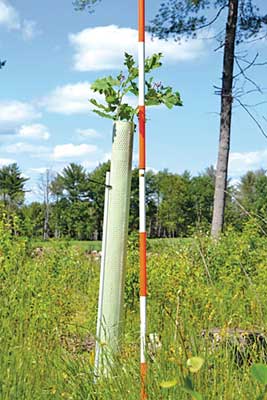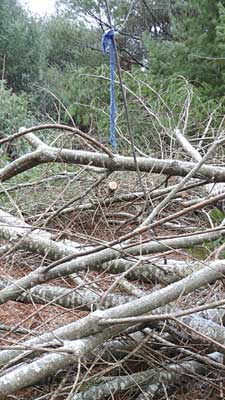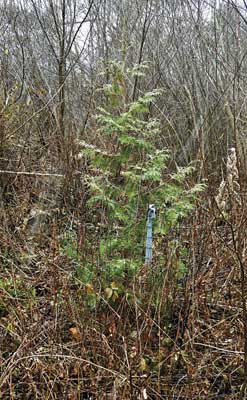By Stephen J. Barr, M.D.
The best time to plant a tree was 20 years ago. The second-best time is now.
– Chinese proverb
Perhaps you have some woods behind your house, or perhaps you’re fortunate and have a fair amount of land. Maybe you’re a member of a local land trust and would like to volunteer your energy toward forest restoration.
The natural beauty we enjoy as residents of Maine faces many challenges, including climate change, acid rain, invasive plants such as Asiatic bittersweet and honeysuckle, invasive insects such as the woolly adelgid and emerald ash borer, and infectious fungi. We are fortunate that over 90 percent of Maine remains forested. However, few forests in Maine retain the biological diversity of trees they had before colonization by Europeans in the 1600s.
A wonderful book, “Forest Trees of Maine,” originally published in 1908, outlines the native species of trees and their ranges in Maine. Revised in 2008, the centennial book marks the 14th edition! It describes each tree and its original range in the state. This compact publication inspired me to begin planting trees that have been extirpated from the local landscape, either secondary to their value as lumber or because they favored land that was good for farming, which was then clear cut years ago. (The 216-page spiral bound publication is available for $15 from the Maine Forest Service (https://www10.informe.org/webshop_ifw/index.php?p=6547&c=126&storeID=8) and as a free PDF at https://www1.maine.gov/dacf/mfs/publications/.) Further detail can be found in the USDA’s “silvics manual,” which lists comprehensive information for each important tree species in North America, including detailed range maps, site requirements, growth characteristics and so on. (The 1990 edition of “Silvics of North America,” USDA Agriculture Handbook 654, is available as a free PDF – Vol. 1. Conifers at https://www.fs.usda.gov/treesearch/pubs/1547 and Vol. 2. Hardwoods at https://www.srs.fs.usda.gov/pubs/1548.)
When I audited the trees on my land in Cumberland County, many of the more than 78 tree species native to Maine were missing, including black tupelo (black gum), black oak, scarlet oak, chestnut oak, swamp white oak, American chestnut, striped maple, butternut, shagbark hickory, bitternut hickory, black walnut, sycamore, pitch pine, Atlantic white cedar, northern white cedar, sassafras, silver maple, mountain paper pitch and witch hazel. I was able to find all the other species.
Restoration ecologists preach that the strength of a forest depends on its biological diversity. To this end, reinstating these lost species of trees makes sense. I spoke with Amber Roth, Ph.D., an assistant professor of forestry at UMaine, and she asked, “Why is the species not there now?” Perhaps the trees were lumbered to extinction. Perhaps the land is reclaimed farmland that was clear cut originally, removing mature canopy trees, which were no longer present or capable of regeneration. Maybe they were diseased and died; maybe the soil was poor and did not support the necessary requirements of the particular tree. In addition, many of the trees extirpated are long-lived and slow-growing. They will most likely need our help to give them a competitive advantage to get started and gain a foothold over some of the faster growing, more numerous trees we have in Maine, such red maple, pin cherry, white pine and red oak, to name just a few.
Where do you find trees for replanting your forest? Sometimes I start seedlings myself, when I find seeds from a local specimen. Municipal parks, old libraries, some schools and old homes often have old trees giving off nuts or seeds that you can collect. These seeds, which may require certain conditions called “stratification” to break dormancy, will often sprout, and you will have your own specimens, perhaps descendants of native trees that were in the local forest many years ago. Stratification often requires a period of dormancy, cold and moist conditions to “turn on” the germination of the particular seed. A good source of information about treating seeds to break dormancy is “The Reference Manual of Woody Plant Propagation” by Michael Dirr and Charles Heuser Jr. (Varsity Press, 2006). And a wonderful old publication from the Arnold Arboretum can help you plan when to collect seeds: “Seed Collection Dates of Woody Plants,” Arnoldia, Oct. 10, 1947 (https://arnoldia.arboretum.harvard.edu/pdf/articles/1947-7–seed-collection-dates-of-woody-plants.pdf).
Mail order is another source of seedlings. The Fedco catalog contains many of the native trees of Maine. The American Chestnut Foundation is developing a disease-resistant chestnut tree by backcrossing blight resistant Chinese chestnuts with the native American chestnut (see www.acf.org). Sometimes young trees are available at the Common Ground Country Fair, The Great Maine Apple Day or the Seed Swap and Scion Exchange, all held at MOFGA’s Common Ground Education Center in Unity.
Once you identify and source the trees you need, plant them in the right soil subtype (e.g., wet versus dry, sandy vs. clayey, etc.) and microclimate (e.g., warm or cold) and protect them from browsing animals. Maxwell McCormack, a research professor emeritus at the University of Maine, favors using tree shelter tubes (Photo 1). One of the better ones on the market is Tree Pro (https://www.treepro.com). These tubes allow 95 percent transmission of light, increase retention of moisture, and hold browsing from deer to a minimum until trees are tall enough to reach above the deer’s height. The tubes also discourage rodent damage of the nubile bark. Often they will fall off after the tree grows to a certain width, pushing them open and off the growing tree. Most recommend taking them off once five to seven years have gone by and trees are of sufficient height.
I sometimes make a crib from old branches to deter deer. This is easy if you are planting at the base of a blowdown, where lots of branches are available to stack as a fence to deter deer. As an added benefit, as the branches biodegrade, they release nutrients for the growing trees (Photo 2). I also may use metal fencing, making a roll, which I stake by pushing branches into the earth around it. In this case, I revisit the tree yearly and remove the fence once the tree is high enough (Photo 3). All small trees are at risk from rodents gnawing the bark in winter, and there are some tricks to deter them as well. Small trees can establish roots quicker and are cheaper but may be more susceptible to browsing.
Remembering where your trees are is also a challenge. Mark them well with a stake and a few cloth rags of a noticeable color. Programs available on your cell phone may also help you mark the location of the seedlings with GPS coordinates, allowing you to document the year planted, species, and then mark the location to within 16 feet (the built-in error in most GPS systems).
Local land trusts could start a “tree adoption” program on their conserved lands. Volunteers might plant and adopt a tree that is not found in the local area but was once native there. They then tend it when it is most vulnerable, visiting the tree frequently to control local growth around it, and perhaps applying some hugelkultur at the drip line to add nutrients. In case of a blowdown, perhaps a different species might be planted in its place. You might even cut down an over-represented species and plant at its base. Newly planted canopy trees may help control invasive plants – often a challenge in conservation easements.
The future brings uncertainty with the extension and spread of invasive plants, insects, fungi, climate change and variable precipitation patterns. Their effects on Maine in the coming years remain a cause for worry. Robert Seymour, Ph.D., Curtis Hutchins Professor of Forest Resources at UMaine, says that “assisted migration” may help hedge our bets against climate change (personal communication). Maybe planting such trees as black walnut, American sycamore, pitch pine, many of the oaks, Atlantic white cedar and American chestnut, already at the northern end of their historic range in Maine, will keep the forests healthy. Restoring tree species to local areas helps increase local biological diversity and adaptability, which may help the forest and the fauna that inhabit that forest meet present and coming challenges.
About the author: Stephen J. Barr, M.D., is an orthopedic surgeon practicing in Portland. He is an avid forager for mushrooms, an organic beekeeper, and has loved trees from an early age. He lives with his wife and three children in North Yarmouth, Maine. He counts three victories in the Harry S. Truman manure toss at MOFGA’s Common Ground Country Fair in his list of accomplishments. Despite ridicule from his brother for “planting trees in the forest,” he presses on, inspired by the fictitious Elzéard Bouffier, a French shepherd who singlehandedly planted thousands of trees, restoring a deforested landscape of the Alps in Provence.



